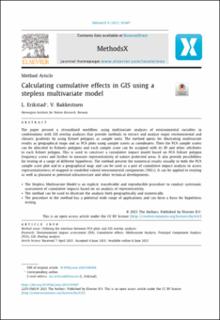Calculating cumulative effects in GIS using a stepless multivariate model
Peer reviewed, Journal article
Published version

Åpne
Permanent lenke
https://hdl.handle.net/11250/2759900Utgivelsesdato
2021Metadata
Vis full innførselSamlinger
- Publikasjoner fra CRIStin - NINA [2364]
- Scientific publications [1392]
Originalversjon
10.1016/j.eiar.2020.106458Sammendrag
The paper present a streamlined workflow, using multivariate analyses of environmental variables in combinations with GIS overlay analyses that provide methods to extract and analyse major environmental and climatic gradients by using fishnet polygons as sample units. The method opens for illustrating multivariate results as geographical maps and as PCA plots using sample scores as coordinates. Then the PCA sample scores can be allocated to fishnets polygons and each sample score can be assigned with its ID and other attributes to each fishnet polygon. This is used to construct a cumulative impact model based on PCA fishnet polygon frequency scores and further to measure representativity of nature protected areas. It also provide possibilities for testing of a range of different hypothesis. The method present the numerical results visually in both the PCA sample score plot and in a geographical map, and can be used as a part of cumulative impact analysis to assess representativeness of mapped or modelled valued environmental components (VECs). It can be applied to existing as well as planned or potential infrastructure and other technical developments. •The Stepless Multivariate Model is an explicit, transferable and reproducible procedure to conduct systematic assessment of cumulative impacts based on an analysis of representativity. •The method can be used to illustrate the analysis both geographically and numerically. •The procedure in the method has a potential wide range of applications and can form a basis for hypothesis testing. Environmental impact assessment (EIA), Cumulative effects, Multivariate Analysis, Principal Component Analysis (PCA), GIS, Overlay analysis
